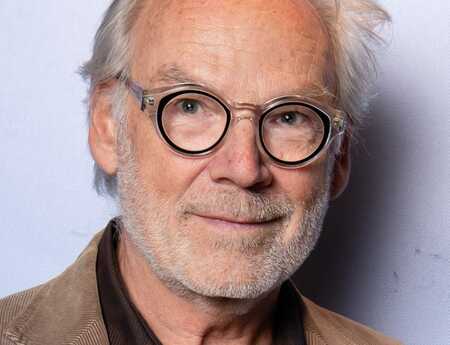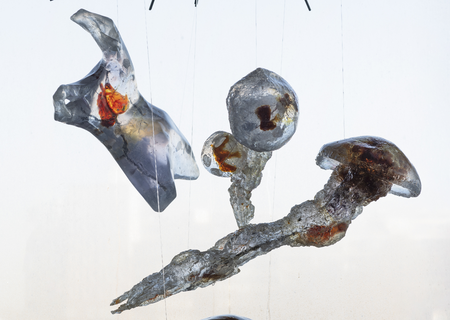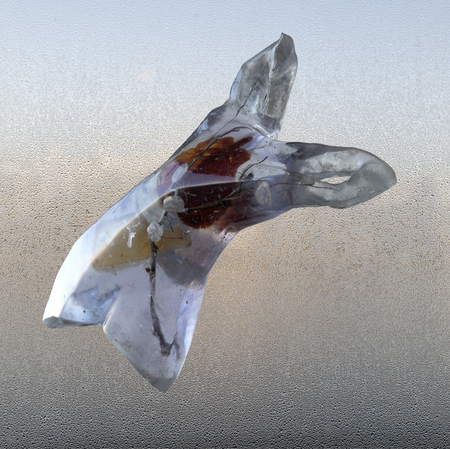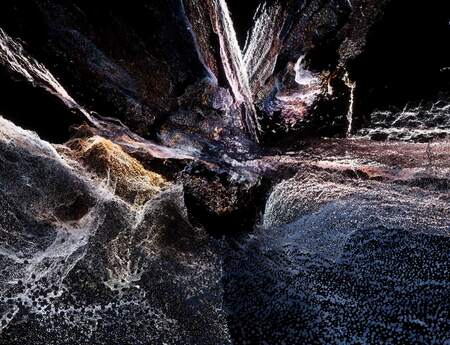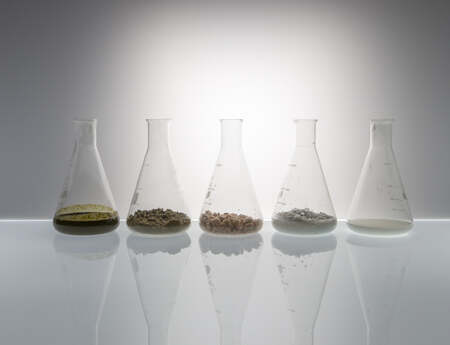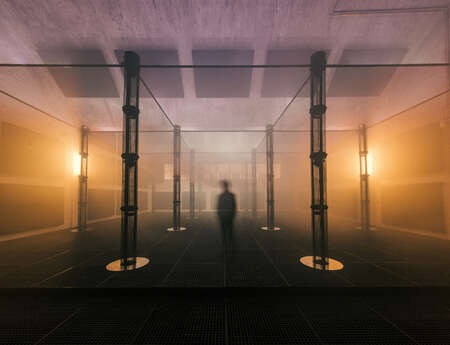“We are polluting the place to a great extent.” – Caroline Kampfraath and The Tentacles of the River
Sculptors are masters of visualization and persuasion; with their works they tell stories that stick. When it comes to the climate, their approach is not necessarily scientific or apocalyptic, they are rather concerned with awareness and exerting influence. In her work, Caroline Kampfraath shows that our interaction with nature and the environment is disastrous. Can the general public be convinced of the need to modify its behaviour so that we can secure our future on earth?
Sculptor Caroline Kampfraath is socially driven, both as an artist and as an individual. In her work she identifies social wrongs and also refers to the enormous damage that human activity causes to our environment. For her assignment by consultancy firm Yellow Research in Amsterdam she was given carte blanche. However, the management team did stipulate that they could follow the creative process on a biweekly basis, whereby they were especially interested in the thought process that underpins the creation of the sculpture.
Making process
Caroline produced a unique, rotating installation, which she installed in front of the panoramic windows of the office with a wide view of the river IJ.
What were your initial starting points for the installation?
"A hanging sculpture seemed better to me than a standing one in that location, because the entire front of the office consists of a large 4 x 10 meter glass wall. With the work I wanted to establish a direct relationship between the IJ river and what Yellow Research employees are doing there. The title became 'The Tentacles of the River'."
What kind of consulting firm is it about?
"It is a consulting firm that assists scientists in applying for grants for their own research plans that should be aimed at opening up new directions in research. According to the clients, the process involved in applying for these types of grants is very similar to the process an artist goes through when creating a work. In particular: what is the process from idea to realization, what is it you do not know, what is the underlying idea, why is that important to where you want to end up? And, how does knowledge and insight play a role when you take a new direction with your work? When should you rely on your own knowledge and insight, and at which point should you dare to take a leap of faith? These questions in particular were asked to me by the client during the making process."
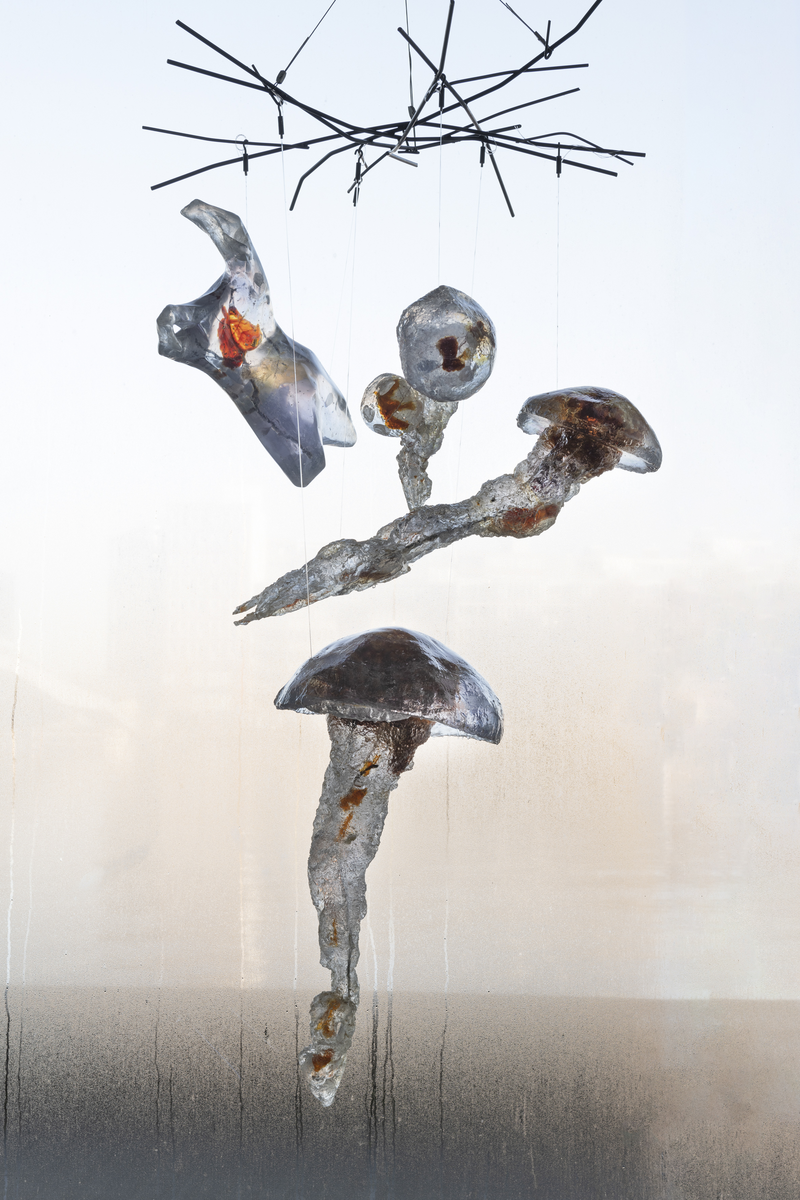
Tentacles as a metaphor
The centerpiece of ‘The Tentacles of the River’ is a hanging plastic bag made of transparent polyester, which may also be seen as a torso. Inside the bag you see a lung made of orange tree resin. Around it hang five jellyfish, also made of polyester. Clearly visible, inside two of them are brains, again made of tree resin.
A rather elusive work?
"I prefer to make sculptures where something extra happens inside. That way I can use the form as a container for an underlying idea. Because this work rotates, you get to see all sorts of facets of the installation. The whole indeed never becomes completely clear that way, and that is also my intention."
What do the respective parts of the sculpture stand for?
"With the sculpture, I am telling a story within a story. The human lungs show that we are connected to nature, represented by the jellyfish. There is also a branch of a tree through all the works and you can see kite wires. The whole thing represents the broader story of our Being. The breathing, the thinking, the feeling of happiness: it all comes through. Eventually, it has become a positive work in which all kinds of connections are made."
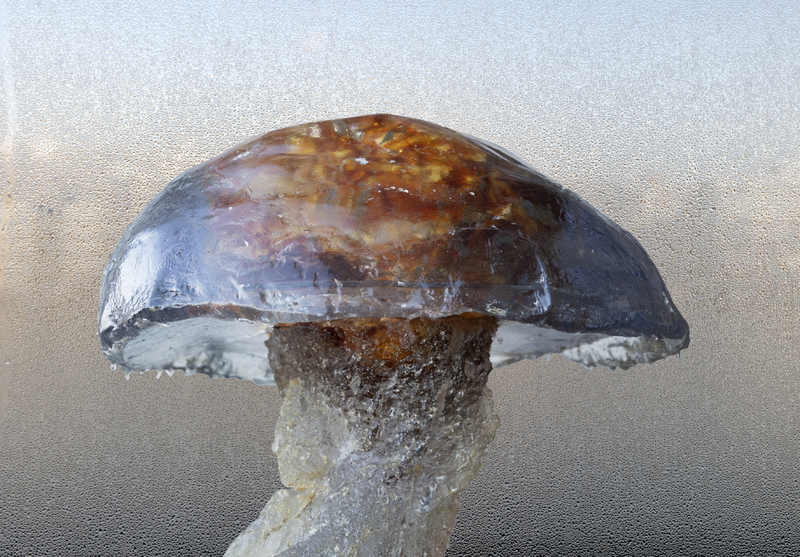
Microplastics and global warming
Last year the Vitra Design Museum showed the exhibition “Plastik. Die Welt neu denken.” You got to see an interesting overview from the development and the ever-increasing use of plastics in the 20th century to the devastating effects on nature and the environment happening today.
Surely your installation also refers indirectly to the plastic soup in oceans and the plastic microparticles in our drinking water?
"That plastic bag certainly refers to our human actions but also points to the connection between us humans. We all look at it with a certain latency: ‘This is the way it is.’ After all, those microplastics are in everything. In clothes, sweaters, makeup, toothpaste, etc. You also find them in the air and because you breathe, they get into your lungs.
The bag refers to the fact that our environment is in such bad shape; we are polluting things to a great extent. Everywhere you see plastic lying around in the water, on the street. We think we are throwing something away, but eventually it ends up in our bodies; we eat it ourselves or breathe it in."
And then those jellyfish in your installation, how should I see them?
"Those jellyfish formed in polyester are a metaphor for global warming. For example, all sorts of exotic jellyfish species can now survive in the IJ, jellyfish that don't belong there at all. New species -such as the crayfish- often displace existing ones elsewhere, and because they have no natural enemies, they become a plague. Warming has already caused many animal and plant species to disappear. Ultimately, this is all at our expense; we are destroying ourselves with it. Those lungs, those brains that are in the jellyfish; that's us. We are in that image, with which I want to show, 'We are a part of nature.'"
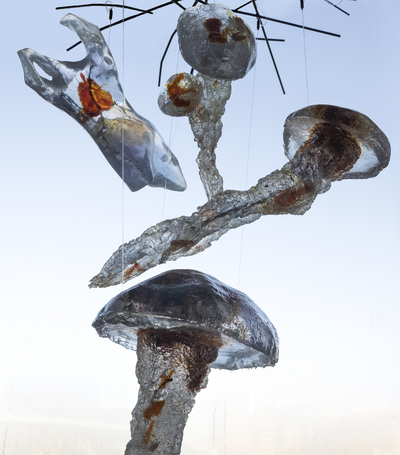
The role of art
Climate activists and people that are concerned with the future of our planet often wonder how the majority of mankind can be convinced to adapt its consuming behaviour.
"One solution could be scarcity: fewer clothes, less flying, not buying the latest mobile phone straight away. In short, using raw materials differently: they are becoming scarce. So we should reject the normality of consuming in the current way; consuming more and more adds nothing. We have to find other ways to achieve our well-being.”
Do you think art can play a role in this change in consumer behaviour?
"Certainly, I then think of the work of Barbara Hepworth. At that time, artists were very concerned with social change. She was of the opinion that 3D art can make things palpable, because this kind of art responds very directly to the environment and to feelings. I also wanted to incorporate that effect into my sculpture. Standing in front of it, you look through it on one side, from the other side you see other facets. You can never fully grasp the work, even if it rotates. People get intrigued and wonder: what is happening there? Art doesn't change the world, but it can make subjects tangible. It appeals to people's consciousness; art adds something in our human consciousness that you can never quite express in words."
Caroline Kampfraath
Caroline is socially driven, both as a person and an artist. In her work she highlights the urgency and impact of global crises, which are currently upon us and permeate our collective consciousness. Her Dead Dogs Envelope heralded the fragmentation and loneliness that social media often create. Her installation The Trees Will Weep Upon Us, We'll be Fossils by Then, an installation she showed at the 2017 Venice Biennale, highlighted mankind's careless neglect of the environment; humanity is making itself disappear, all that remains of human civilization are a few broken bottles.
Copyright 2023 © Etienne Boileau

